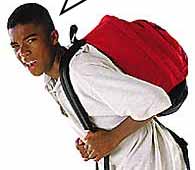

Association of Relative Backpack Weight With Reported Pain,
Pain Sites, Medical Utilization, and Lost School Time
in Children and AdolescentsThis section is compiled by Frank M. Painter, D.C.
Send all comments or additions to: Frankp@chiro.org




FROM: J Sch Health. 2007 (May); 77 (5): 232–239
Moore MJ, White GL, Moore DL.
Moore Chiropractic Wellness Centre,
1484 Hartnell Ave., #B,
Redding, CA 96002, USA.
BACKGROUND: There is debate about a 10% versus 15% of body weight cutoff point for safe weight of school backpacks. Estimation of the cutoff may be affected by use of survey methods and failure to assess pain experienced while wearing a backpack. Previous research also suggests that younger students and females are more at risk for developing backpack pain.
METHODS: Five hundred and thirty-one 5th- to 12th-grade Northern California students and their backpacks were weighed. Students were individually interviewed about how often they experienced pain while carrying a backpack, the site of their pain, and if the pain had interfered with school activities or led to medical care.
RESULTS: Data support the use of a 10% of body weight cutoff for safe use of backpacks for all grade levels. Younger students and females are more at risk due to relatively lower body weight while females also carry heavier backpacks than males. Greater relative backpack weight is associated with upper- and mid-back pain reports but not neck or lower back pain; it is also associated with lost school time, lost school sports time, and greater chiropractic utilization.
CONCLUSIONS: The 10% cutoff is recommended along with a variety of practical methods to help schools achieve that goal for middle and high school students.

Return to BACKPACKS
Since 5-15-2010


| Home Page | Visit Our Sponsors | Become a Sponsor |
Please read our DISCLAIMER |
